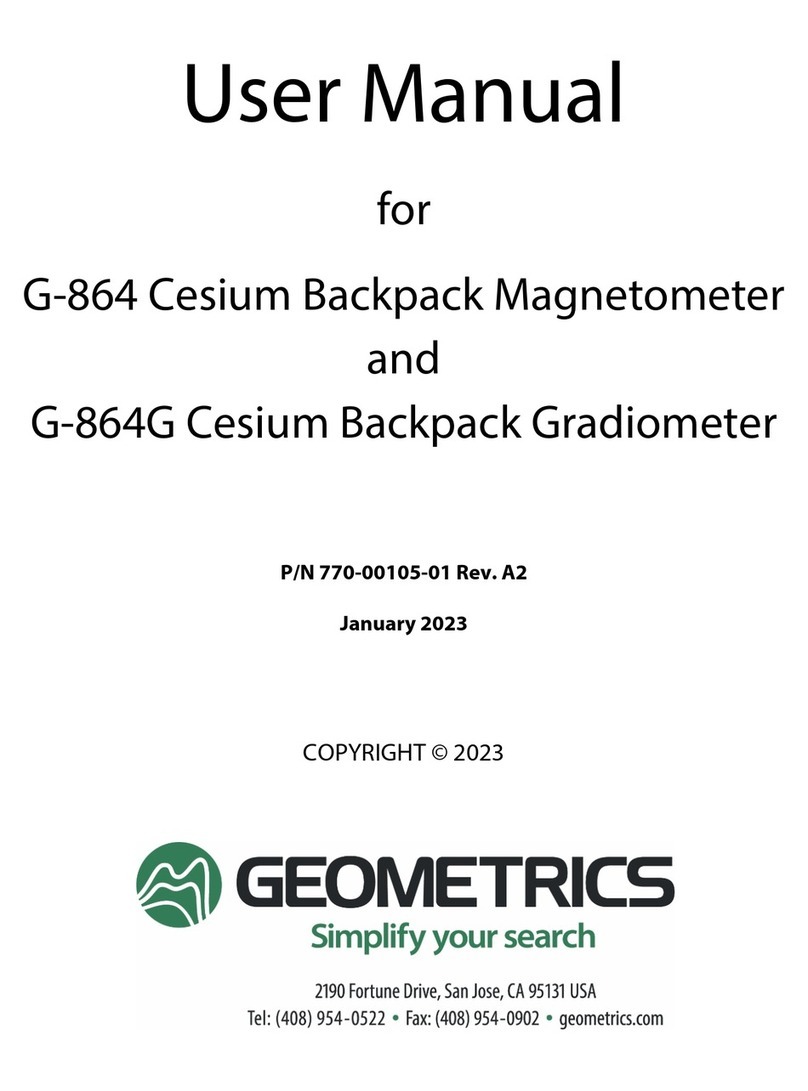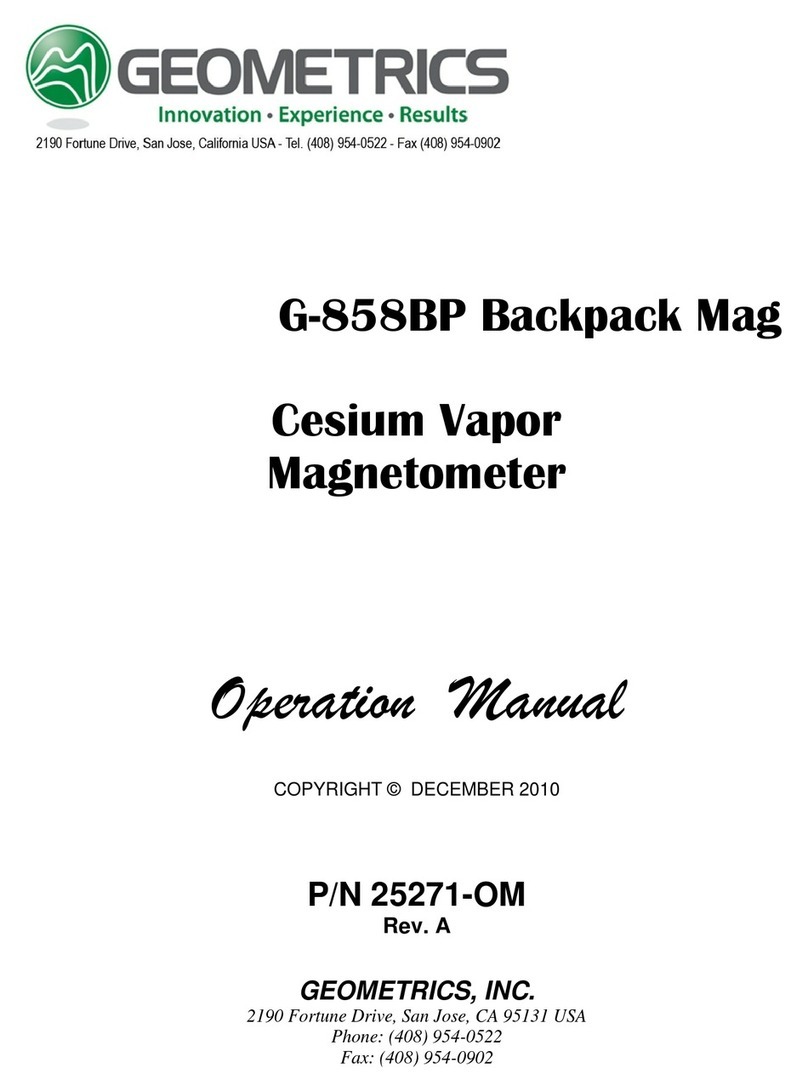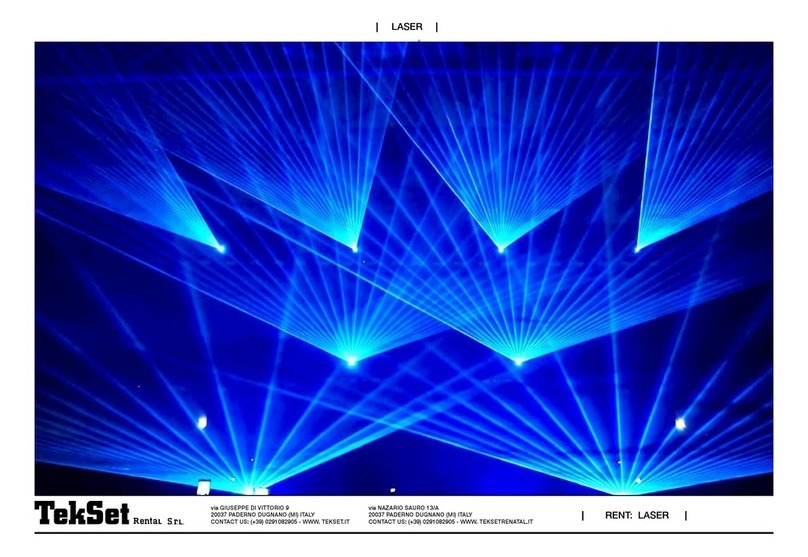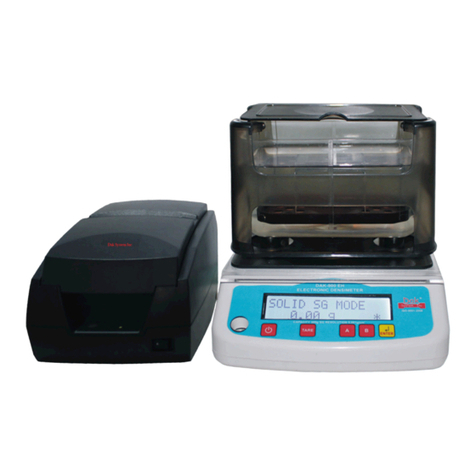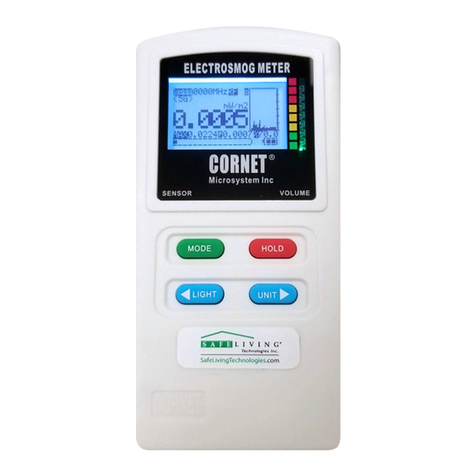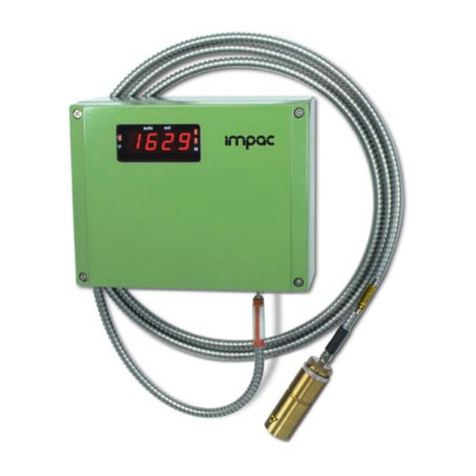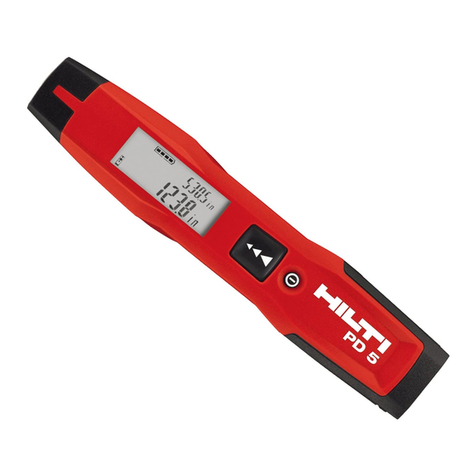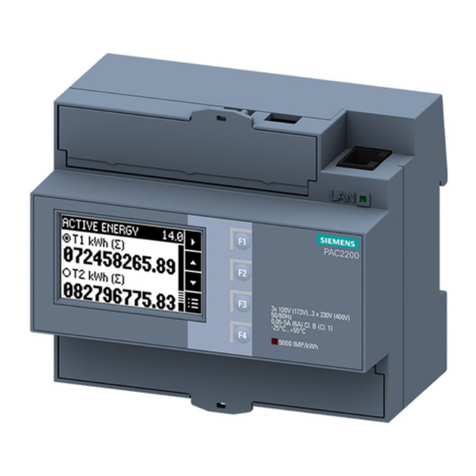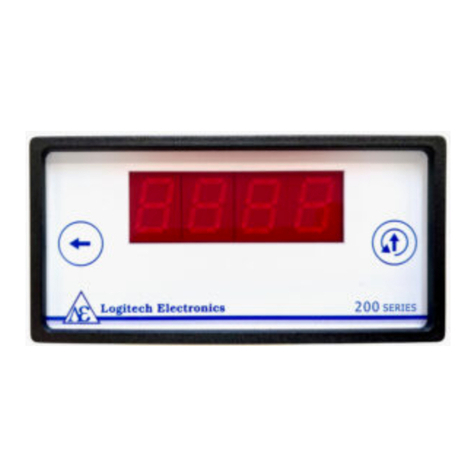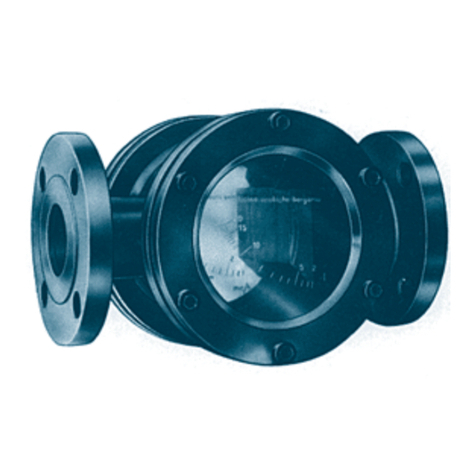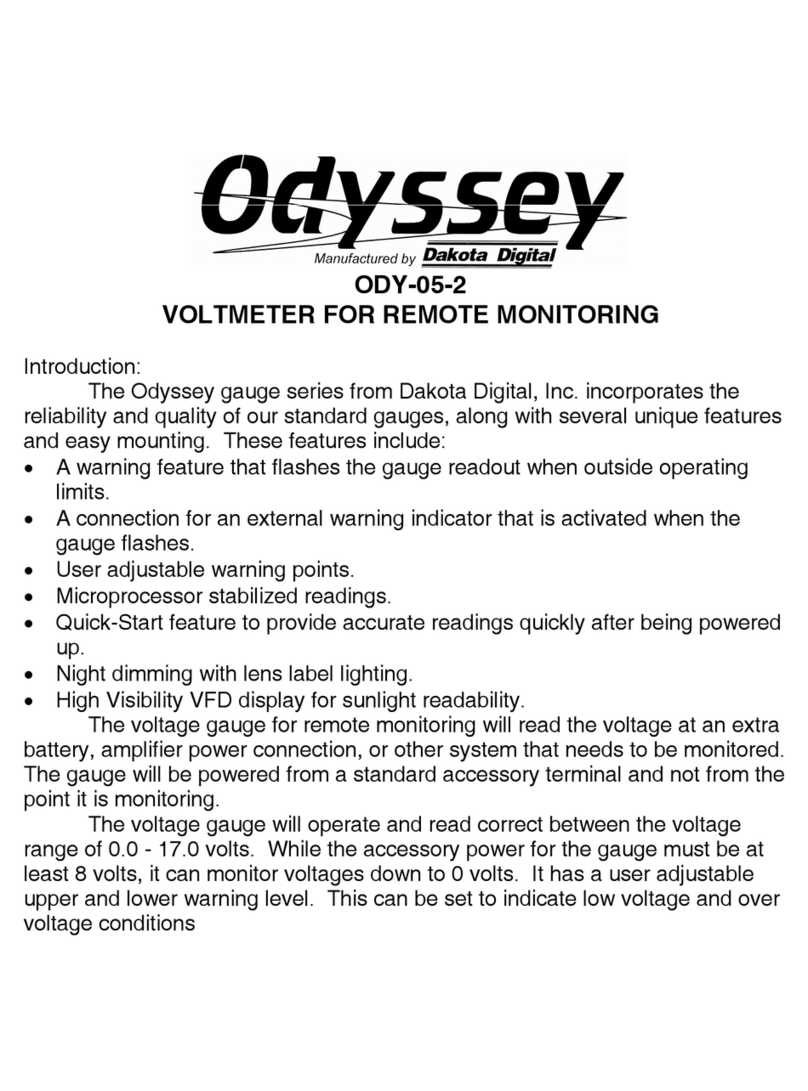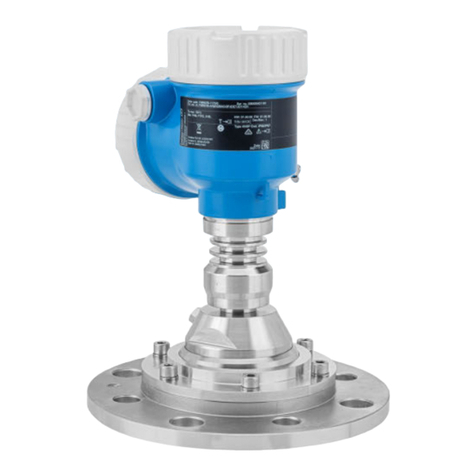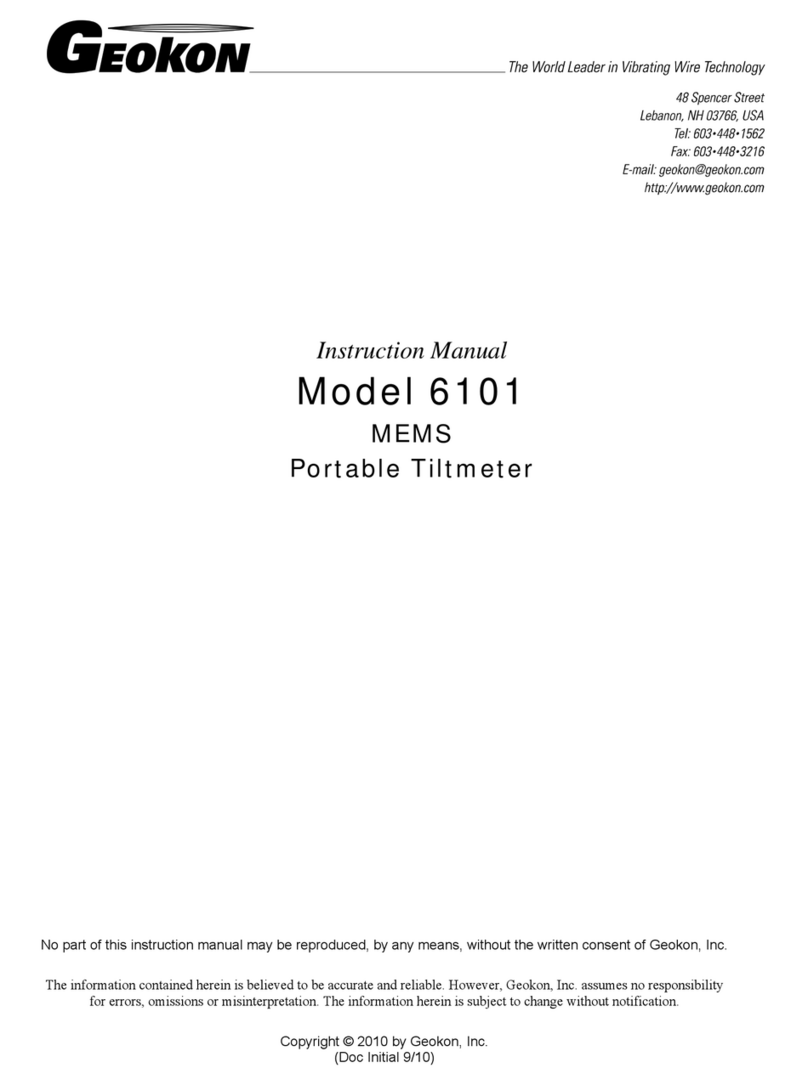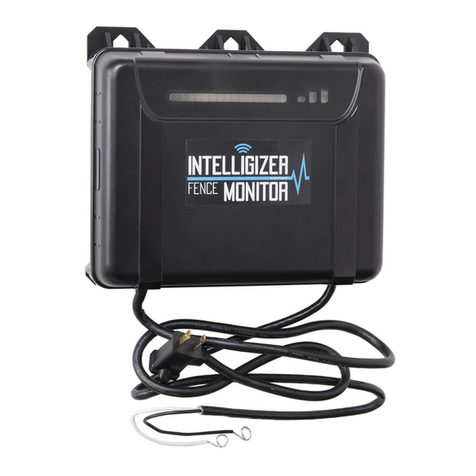Geometrics G-822A User manual

G-822A and G-823A & B
CESIUM MAGNETOMETER
27597-OM REV. B5
GEOMETRICS, INC.
2190 Fortune Drive, San Jose, CA 95131 USA
Phone: (408) 954-0522
Fax: (408) 954-0902
EMAIL: [email protected]m
Operation Manual
COPYRIGHT © 2004

ii

Geometrics, Inc. G-822/G-823 Magnetometer Manual
iii
TABLE OF CONTENTS
1.0 INTRODUCTION...............................................................................................................1
2.0 SYSTEM COMPONENTS..................................................................................................2
3.0 PERFORMANCE................................................................................................................3
4.0 INSTALLATION .................................................................................................................4
4.1 Sensor orientation.........................................................................................................................................................5
4.2 Sensor attachment ......................................................................................................................................................10
4.3 Environmental Considerations..................................................................................................................................11
Vibration........................................................................................................................................................................11
Electronic/electromagnetic.............................................................................................................................................11
Temperature...................................................................................................................................................................12
5.0 OPERATION ....................................................................................................................12
6.0 TROUBLE SHOOTING....................................................................................................13
7.0 G-823A MAGNETOMETER .............................................................................................14
7.1 CM-201 Output Format.............................................................................................................................................16
7.2 Commands...................................................................................................................................................................18
7.3 Detailed command descriptions:................................................................................................................................22
Cycle Time Set...............................................................................................................................................................22
A/D channel select/enable..............................................................................................................................................22
Baud Rate Change..........................................................................................................................................................23
Output Format Select.....................................................................................................................................................23
Julian Time Set ..............................................................................................................................................................27
Julian Time Enable ........................................................................................................................................................27
Julian Output format ......................................................................................................................................................28
Find Counters.................................................................................................................................................................28
Set Preamble character...................................................................................................................................................29
Echo Error command.....................................................................................................................................................29
Interrogate Setup command ...........................................................................................................................................29
Analog channels.............................................................................................................................................................29
Reset command..............................................................................................................................................................30
Jump to debug................................................................................................................................................................30
7.4 Power-up Initialization...............................................................................................................................................31

Geometrics, Inc. G-822/G-823 Magnetometer Manual
iv
8.0 G-823B MAGNETOMETER .............................................................................................31
9.0 ACCESSORY SOFTWARE.............................................................................................32
9.1 CM-201........................................................................................................................................................................32
install.bat........................................................................................................................................................................33
cm201set.bat..................................................................................................................................................................33
cm201.bat.......................................................................................................................................................................33
cm201go.exe..................................................................................................................................................................33
commflip.exe .................................................................................................................................................................34
batmenu.exe, drawbox.exe, gotoxy.exe, yymmdd.exe, foreach.exe, getkey.com...........................................................34
9.2 Cesium Sensor Azimuth Program - CsAz..............................................................................................................34
9.3 View201 .......................................................................................................................................................................36
Function Keys................................................................................................................................................................37
Displaying Analog Channels..........................................................................................................................................39
Display channel ON/OFF [0/1]:.....................................................................................................................................39
Counter Number [0-2]: ..................................................................................................................................................40
Analog Channel Number [0-5]:......................................................................................................................................40
Unipolar/Bipolar [U/B]..................................................................................................................................................40
Clip/Wrap [C/W] ...........................................................................................................................................................40
Full Scale Set.................................................................................................................................................................40
Label..............................................................................................................................................................................41
Set trace color ................................................................................................................................................................41
APPENDIX A1. MODEL G-822A SPECIFICATIONS.............................................................43
APPENDIX A2. MODEL G-823A SPECIFICATIONS.............................................................44
APPENDIX A3. SENSOR INSTALLATIONS .........................................................................45
APPENDIX A4. CESIUM-VAPOR SENSOR THEORY..........................................................50
APPENDIX A5. G-822A GENERAL BLOCK DIAGRAM OF SYSTEM COMPONENTS.......54
APPENDIX A6. G-823A GENERAL BLOCK DIAGRAM OF SYSTEM COMPONENTS.......55
APPENDIX A7. G-823B GENERAL BLOCK DIAGRAM OF SYSTEM COMPONENTS.......56
LIST OF FIGURES AND TABLES
FIGURE 1. G-822A SENSOR AND SENSOR DRIVER MODULE........................................................................1
FIGURE 2. G-822A SYSTEM COMPONENTS .................................................................................................2
FIGURE 3. ACTIVE ZONE FOR THE CESIUM-VAPOR SENSOR. .......................................................................3
FIGURE 4. SURFACE INCLINATION OF THE EARTH’S MAGNETIC FIELD. ........................................................4
FIGURE 5. MAGNETIC FIELD INTENSITY AT THE EARTH’S SURFACE. ..........................................................5

Geometrics, Inc. G-822/G-823 Magnetometer Manual
v
FIGURE 6. MID-LATITUDE ZONE.................................................................................................................6
FIGURE 7. POLAR LATITUDE ZONES............................................................................................................7
FIGURE 8. EQUATORIAL LATITUDE ZONE -1...............................................................................................8
FIGURE 9. EQUATORIAL LATITUDE ZONE -2...............................................................................................8
FIGURE 10 .SENSOR MOUNT THAT PROVIDES FOR TWO AXES OF ADJUSTMENT.........................................10
FIGURE 11. SIGNAL DECOUPLER CIRCUIT .................................................................................................12
FIGURE 12. SCHEMATIC OF CM-201, MAGNETOMETER,AND COMPUTER CONNECTIONS ..........................16
FIGURE 13. SCHEMATIC DIAGRAM OF DAISY-CHAINED CM-201 COUNTER MODULES.................................18
FIGURE 14. G-823B INSTALLED AS BASE-STATION MAGNETOMETER. ......................................................32
TABLE 1. G-822A STANDARD COMPONENT WEIGHTS AND DIMENSIONS.....................................................2
TABLE 2. TROUBLE SHOOTING .................................................................................................................13
TABLE 3. G-823A STANDARD COMPONENT WEIGHTS AND DIMENSIONS...................................................15
TABLE 4. G-823A INTERFACE CABLE PIN-OUT .........................................................................................15
TABLE 5. EXAMPLE OF CM-201 DEFAULT OUTPUT DATA STREAM...........................................................17

Geometrics, Inc. G-822/G-823 Magnetometer Manual
vi

Geometrics, Inc. G-822/G-823 Magnetometer Manual
1
1.0 INTRODUCTION
Congratulations on your purchase or rental of one of the finest cesium vapor
magnetometers ever produced. This manual will provide you with an understanding of
alkali vapor magnetometer technology and will give you instructions for installing the
system for airborne, land or marine use. It is not meant to be exhaustive for every case as
there are many different situations and applications in which magnetometers can be used.
Please contact the factory if you have specific questions relating to your special
application.
The Geometrics G-822A and G-823A magnetometers employ an optically pumped
Cesium-vapor atomic magnetic resonance system that functions as the frequency control
element in an oscillator circuit. The G-823A is simply a G-822A containing additional
counter circuitry that internally converts the magnetometer’s analog signal into a digital
RS−232 output. Because the G-822A is identical to the G-823A in all other respects, the
installation instructions are provided referencing the G-822A only. However they apply
to the G-823A as well. A description of the G-823A operation is presented in the last
chapter.
The frequency of the magnetometer
electrical oscillator is known as the
Larmor frequency and it varies directly
with the ambient magnetic field at the
sensor. When this frequency is
accurately measured it provides a
precise measurement of the total
magnetic field. The design of the
sensor optical package uses a split-
beam design which eliminates the need
to optimize sensor orientation to obtain
precise measurements.
As shown in Figure 1, the G-822A
magnetometer consists of two
interconnected modules: a sensor
module and sensor driver module.
The G-822A relies on counter circuitry
that is external to the sensor driver
module, that can be a Geometrics
SuperCounter, an RMS Instruments
AADC II, or other form of counting
device. Some users elect to use their
own counter circuitry with the G-822A.
In these cases Geometrics can supply an
Figure 1. G-822A Sensor and Sensor driver module

Geometrics, Inc. G-822/G-823 Magnetometer Manual
2
optional power/signal decoupler (P/N 27560-01) to interface the sensor driver module to
both the power supply and an external counter.
A basic understanding of the physics employed in the G-822A, and optically pumped
resonance magnetometers in general, is valuable for troubleshooting new installations and
for achieving optimum results during field use, but is not essential for either. Such basic
information can be found in the Appendix of this manual.
2.0 SYSTEM COMPONENTS
The basic system components of the G-822A consist of the sensor module, a sensor driver
module, and an interconnect cable that is permanently attached to the sensor module and
detachable from the sensor driver module. These components are identified in Figure 2.
The weights, dimensions, and connector’s specifications for these components and
ancillary system components are listed in the Table 1.
Description
Weight
Dimensions
Cesium sensor package
P/N 27516-01
1lb. 8oz.
2’3/8”x5-1/2” cylindrical housing with 109 in. cable.
Termination: Burndy 0119 G6JF12-88 PNE
G-822A Sensor driver module
P/N 27512-01
2 lbs.
12-5/8” including connectors.
11-5/8” long x 2-1/2” cylindrical housing
Analog signal/power cable
P/N 27565-02
14oz.
33’ coaxial with BNC termination
Carrying Case
P/N 27615-01
10 lbs.
18l” x 9.5w” x 15h”
Figure 2. G-822A system components
Table 1. G-822A standard component weights and dimensions
Sensor Module
Sensor Driver Module
Interconnect
Cable

Geometrics, Inc. G-822/G-823 Magnetometer Manual
3
A single coaxial cable connected to the BNC connector on the sensor driver module
carries power to and signal from the module. This BNC connection is located next to the
interconnect cable. This coaxial cable may be as long as 200ft (61m) for interconnection
with a power/signal decoupler (e.g. Geometrics P/N 27560-01)
3.0 PERFORMANCE
Geometrics G-822A magnetometer produces a Cesium Larmor frequency output at
3.498572 Hz per nT. ‘nT’ refers to the magnetic field strength as measured in nanoTesla.
1nT equals one gamma or 10-5 gauss. So, at the earth’s surface, in a nominal 50,000nT
field, the Larmor frequency is about 175 kHz. The output of the G-822A is a continuous
sine wave at the Larmor frequency. The typical signal amplitude is from 1 to 2 volts
peak-to-peak with the sensor in its optimal orientation.
The G-822A is intended for use in airborne, marine, land and base station applications,
and operates over the earth's magnetic field range of 20,000 to 100,000nT. Absolute
accuracy depends on sensor orientation, internal light shift and the accuracy of the
external counter's time base. Error due to orientation of the G-822A does not exceed
±0.25nT or 0.5 nT peak-to-peak (p-p) throughout the active zones shown in Figure 3.
Environmental conditions for proper operation are -35 to +50°C (-31 to +122° F),
humidity to 99 percent non-condensing, over an altitude range of 0 to 30,000 feet.
Figure 3. Active zone for the cesium-vapor sensor.

Geometrics, Inc. G-822/G-823 Magnetometer Manual
4
Like all magnetometers, performance of the G-822A is primarily dependent upon the
counting circuitry employed and the quality of the installation procedures. Compensation
and/or noise reduction techniques must normally be used to minimize the magnetic effect
of the platform and its motion. Navigational and positional errors, radiated
electromagnetic noise and heading errors from the aircraft's induced and remnant
magnetic fields are typically the major contributors to noise in the survey results.
4.0 INSTALLATION
The particular installation requirements for each system component must be met in order
to obtain the best performance from the system. It is important to remember that the
sensor driver circuit receives a signal from the sensor whose amplitude is normally one
milli-volt as it delivers both heater and lamp oscillator power to the sensor. Anything that
increases the cross-talk between the power and signal circuits or introduces noise into the
power circuit can degrade the sensor output signal and affect system performance. A
BNC terminated coaxial cable is used to supply power to the matching connector on the
G-822A sensor driver module.
Figure 4. Surface inclination of the earth’s magnetic field.
Epoch 2000, 2º contour interval.

Geometrics, Inc. G-822/G-823 Magnetometer Manual
5
4.1 Sensor orientation
Magnetic fields are vector fields. At any point they are defined by their magnitude and
direction. If the G-822A sensor is going to accurately measure the local magnetic field
magnitude, it must be properly oriented relative to the local magnetic field direction.
The sensor head must be oriented so that the local field impinges at an angle of from 30º
to 60º to the cylindrical axis of the sensor, for all platform attitudes. Alignments that
produce a field/axis angle less than 15º place the magnetic field within the sensor’s
"polar dead zone". Similarly, alignments that produce a field/axis angle greater than 75º
place the magnetic field within the sensor’s "equatorial dead zone". The sensor will not
produce usable data when the angle between the earth's field and the cylindrical axis falls
within one of these two zones.
Unless the sensor is quite near very magnetic objects, the local magnetic field will be
almost entirely due to the earth’s magnetic field. So, in latitudes where the inclination of
the earth's field vector is 45º, vertical orientation of the sensor’s axis will allow operation
in all practical flight attitudes. In equatorial regions it may be necessary to orient the
Figure 5. Magnetic field intensity at the Earth’s surface.
Epoch 2000, 1000 nT contour interval.

Geometrics, Inc. G-822/G-823 Magnetometer Manual
6
sensor horizontally and at an angle to the flight path. In polar regions the sensor may be
mounted with its major axis tilted east or west to obtain the desired angle.
The maps in figures 4 and 5 may be used to determine the inclination and total intensity
of the Earth's magnetic field in the intended area of survey. This inclination information
should be used to adjust the sensor orientation for the best performance in the survey
area. The intensity information may be used as a check of the system operation.
In regard to sensor orientation, the Earth’s surface can be divided into three zones based
upon magnetic field inclination: a mid-latitude, equatorial, and polar. Within each of
these zones there is a particular sensor orientation that will yield adequate signal strength
over the entire zone. These regions and the corresponding sensor orientations
recommended for each region are shown in figures 6 through 9.
Figure 6. Mid-latitude zone.
The diagram to the left shows the
recommended sensor orientation
for operation in mid latitudes. This
zone is shown as the shaded
regions above and includes those
areas where the absolute
inclination of the Earth’s magnetic
field is greater or equal to 20º and
less than or equal to 75º. There are
no restrictions on the direction of
travel when using this sensor
orientation.

Geometrics, Inc. G-822/G-823 Magnetometer Manual
7
Note that the orientation zones show in Figures 6 through 9 overlap one another by 10º of
magnetic inclination. In these regions of overlap either of the recommend orientations
may be used. Also, note that in the equatorial region there are two different recommended
sensor orientations. In this region the magnetic field is nearly horizontal and there will be
some restrictions on the direction of flight. Choosing one of the two recommended
orientations will allow you to choose flight directions most suitable for your survey area.
Figure 7. Polar latitude zones.
The diagram to the left shows the
recommended sensor orientation for
operation in polar latitudes. This zone
is shown as the shaded regions above
and includes those areas where the
absolute inclination of the Earth’s
magnetic field is greater or equal to
65º. There are no restrictions on the
direction of travel when using this
sensor orientation.

Geometrics, Inc. G-822/G-823 Magnetometer Manual
8
The diagram to the left shows the
recommended sensor orientation for
operation in equatorial latitudes.
This zone is shown as the shaded
region above and includes those
areas where the absolute inclination
of the Earth’s magnetic field is less
than or equal to 25º.
There are restrictions on the
direction of flight when using this
sensor orientation in this region. The
bottom diagram to the left shows the
flight directions where the sensor will
produce good signal strength. These
flight directions are 60º wide and are
centered on 45º, 135º, 225º, and 315º.
Figure 8. Equatorial latitude zone - 1.
Figure 9. Equatorial latitude zone - 2

Geometrics, Inc. G-822/G-823 Magnetometer Manual
9
The top diagram to the left shows
an alternative sensor orientation
for operation in equatorial
latitudes. This zone is the same
as that shown in figure 8 except
that the sensor is rotated about its
equator by 45º allowing N-S, E-W
survey lines. It includes those
areas where the absolute
inclination of the Earth’s
magnetic field is less than or
equal to 25º.
As with the sensor orientation
shown in Figure 8, there are
restrictions on the direction of
travel when using this sensor
orientation in this region. The
bottom diagram to the left shows
the flight directions where the
sensor will produce adequate
signal strength. These flight
directions are 600wide and are
centered on the cardinal magnetic
field directions 00, 900, 1800, and
2700.

Geometrics, Inc. G-822/G-823 Magnetometer Manual
10
In addition to the diagrams provided here, the program CsAz may be used to calculate the
sensor’s output for a particular orientation for the magnetic field attitude in your survey
area. This is a DOS program and is provided on the Magnetometer Support CD supplied
with your magnetometer.
4.2 Sensor attachment
An acceptable mount for the G-822A sensor will provide a stable, nonmagnetic
attachment to the vehicle, provide vibration dampening and allow the sensor’s orientation
to be adjusted with minimal effort. One example of such a mounting solution is the
sensor mount available from Geometrics (P/N 27530-01). This structure is shown in
Figure 10 below and is designed for attachment inside of a towed bird, a wing pod, or
inside a tail mounted stinger or any circular enclosure with an inside diameter of 7 inches.
Figure 10 . Sensor mount that provides for two axes of adjustment.

Geometrics, Inc. G-822/G-823 Magnetometer Manual
11
4.3 Environmental Considerations
Optically pumped magnetometers are more sensitive to magnetic field variation than are
proton and fluxgate types. To realize the full performance of the cesium-vapor
technology, special precautions must be taken during planning and execution of the
installation.
Vibration
The G-822A is usually installed in aircraft and this environment presents particular
challenges. Intense vibration of system circuitry can induce microphonic noise and
shorten the life of system components. For performance and safety considerations the
sensor, sensor driver, and system cabling are normally hard mounted to the aircraft or are
hard mounted in components that are themselves firmly attached to the aircraft in
structures such as stinger and wingtip pods. Some attachments points may be prone to
intense vibration and we recommend the use of good quality shock mounts that are
designed to isolate the G-822A components from as much of the intense vibration as
possible. Special care should be taken in securing or routing the cable so that it does not
encounter hard or sharp objects that could damage the cable. Those components used to
mount the G-822A sensor or any or any objects near this sensor should be non-magnetic
in order to minimize the system heading error.
Electronic/electromagnetic
Sources of performance problems may arise in two areas: external electromagnetic noise
and errors introduced from platform motion. Electrostatic and electromagnetic signals
from aircraft systems, including other sensor instrumentation, can significantly lower the
signal to noise ratio of the magnetometer. An example is the "hash" created by sparking
brushes in certain aircraft generators. This can be seen as a rapidly changing field value
causing excessive scatter in the readings. The permanent, induced and eddy-current
magnetic fields of the airplane can cause significant errors that are dependent on attitude,
motion and heading in the earth's magnetic field. The use of a device such as the RMS
Instruments’ Automatic Aeromagnetic Digital Compensator, Geometrics software
program MagComp or fixed aero-magnetic compensation techniques will help reduce
these types of errors (See Geometrics technical report TR-15). Variations in electrical
currents in aircraft systems will also cause shifts, bias or increased heading error in the
readings. Consult with Geometrics about the compensation and noise reduction processes
before installation if you are unfamiliar with the procedures used to minimize noise and
platform errors.
G-822A DC power and impressed signal pass through a common, non-magnetic, coaxial
cable. The shield of this cable should not be connected to aircraft/ship ground at any
place other than the decoupler or the G-822A counter. In installations where the counting
electronics are customer supplied, we recommend keeping the DC voltage applied to the
Sensor Electronics between 24 and 33volts DC for proper operation. Although the signal

Geometrics, Inc. G-822/G-823 Magnetometer Manual
12
on this cable is greater than 1 V p-p, coupling noise onto this cable by running it near an
electric motor may still reduce performance.
Temperature
The G-822A is designed to operate over an ambient temperature range of -35 to +50°C.
In an enclosed region it may be necessary to providing adequate cooling by free flowing
air. If the sensor and electronics are in an unconfined region, convection cooling is
generally adequate. The cesium lamp only needs to dissipate 3 to 4 watts of heat and
when operating in cold regions providing some insulation or baffling will help reduce the
sensor’s power consumption.
The G-822A requires a minimum warm up period of 15 minutes. In cold regions the
warm up period will be longer and, to avoid delay, we recommend that the sensor power
be left on overnight when ambient temperatures are expected to fall below -10°C.
5.0 OPERATION
The G-822A produces an analog output signal on the BNC connector of its sensor driver
module. Because this BNC connection also serves as the power input connection it is
necessary to decouple the power from the output signal. The circuit shown in Figure 11
shows a simple decoupling circuit. The output is the Larmor signal and it is a sinusoidal
wave with a peak-to peak amplitude of approximately 2.0 volts and a frequency that will
vary from 70kHz to 350kHz in accordance with the local magnetic field (Cesium oscillator
frequency is 3.498572 Hz per nT). This signal can be observed by attaching the output of
the signal decoupler to an oscilloscope. To be useful as a survey instrument the G-822A’s
Larmor signal must be converted into a digital data stream and this is done by attaching a
counter to the output of a the decoupler circuit.
Figure 11. Signal decoupler circuit

Geometrics, Inc. G-822/G-823 Magnetometer Manual
13
6.0 TROUBLE SHOOTING
Operation of the G-822A is relatively simple and when trouble arises it is usually easy to
recognize and correct. Table 2. is a trouble shooting guide provided to help in quickly
locating the probable cause of the most common system problems.
Symptom
Probable Causes
Corrective Actions
Long warm-up time.
Low voltage.
Low ambient temperature.
Faulty sensor cable
connection.
Low heater setting.
Defective internal sensor or
electronic components.
Increase voltage (minimum 24 VDC at the
electronics) or repair the Coax cable.
Insulate sensor housing.
Disconnect sensor from electronics and
carefully clean the pins and sockets.
Adjust heater to 34.5 K-ohms: contact
factory for details.
Return sensor and electronics to Geometrics
for repair.
Noisy magnetic field
readings.
Local field is noisy.
Sensor not oriented correctly.
Heater setting incorrect.
Signal amplitude too low with
correct orientation.
Sensor cable or connector
worn or damaged.
Locate and eliminate source of noise or
relocate sensor.
Refer to Sensor Orientation section of this
manual, or use MagPick IGRF and CsAz
software to model magnetic field and sensor
behavior, and correct orientation if
necessary.
Adjust heater to 34.5 K-ohms: contact
factory for details.
Adjust signal amplitude or return sensor and
electronics to Geometrics for repair.
Replace sensor cable and connector
assembly. Check connector on electronics
bottle for wear and replace if required.
Sensor cable kinked or
cut.
Handling or mechanical
problem.
Change handling or mechanical mount.
Then replace sensor cable and connector.
Sensor connector
damaged or worn
Handling, mechanical
problem, accident, or normal
wear.
Correct handling or mechanical problem.
Then replace sensor cable and connector.
Excessive current
consumption.
Damaged Coax cable.
Defective sensor or
electronics.
Replace Coax cable.
Return sensor and electronics to Geometrics
for repair.
Preventing a problem is almost always less costly than correcting the problem. We
recommend checking the follow items as part of any new installation or whenever an
Table 2. Trouble shooting

Geometrics, Inc. G-822/G-823 Magnetometer Manual
14
existing installation is altered. It is also recommended that these items are checked
periodically as part of a scheduled platform or system safety check.
1. Power check
a. Minimum 24 Volts DC at electronics bottle. 28VDC recommended
b. Maximum 33 Volts DC at electronics bottle
c. Starting current 1 Ampere at 28 Volts
d. Running current 0.3 to 0.6 Ampere at 28 Volts depending upon ambient
temperature
2. Connector checks
a. Dirt or corrosion
b. Bent pins
c. Back-shell tight
3. Cable jacket check
a. Kinks
b. Abrasions
c. Cuts
4. Sensor orientation
a. Use MagPick IGRF and CsAz to model sensor behavior
b. Adjust sensor orientation and observe dead zones
c. Return sensor to correct orientation for the survey area
5. Field readings
a. Reasonably close to MagPick IGRF model estimate
b. Sample to sample noise less than 0.1 nT @ 10 Hz when not moving
6. Larmor amplitude check and adjustment (Authorized Repair Facility only)
a. Potentiometer on GSN board adjusted for 2.0 Volts Peak to Peak at
50,000 nT after 20 minute warm up
7. Heater check and adjustment (Authorized Repair Facility only)
7.0 G-823A MAGNETOMETER
The addition of Geometrics CM-201 counter assembly board to the G-822A’s sensor driver
module transforms the instrument’s analog output signal into RS-232 digital data. With the
addition of the CM-201, the instrument is designated as the G-823A. The CM-201 counter
module is an integrated circuit that converts the cesium Larmor signal (70 kHz to 350 kHz)
into a numeric value indicating the magnetic field strength in nanotesla (20,000 nT to
100,000 nT). In addition there are 5 external 12 bit A/D channels and 1 internal A/D
channel that can be digitized and appended to the output data. This can be useful, for
instance, in digitizing an analog altimeter signal and incorporating it into the magnetometer
data stream. A Julian clock string can be enabled and added to the output data stream as
well. Finally there is an External Event pin that can be used for external trigger or event
marking.
This manual suits for next models
2
Table of contents
Other Geometrics Measuring Instrument manuals
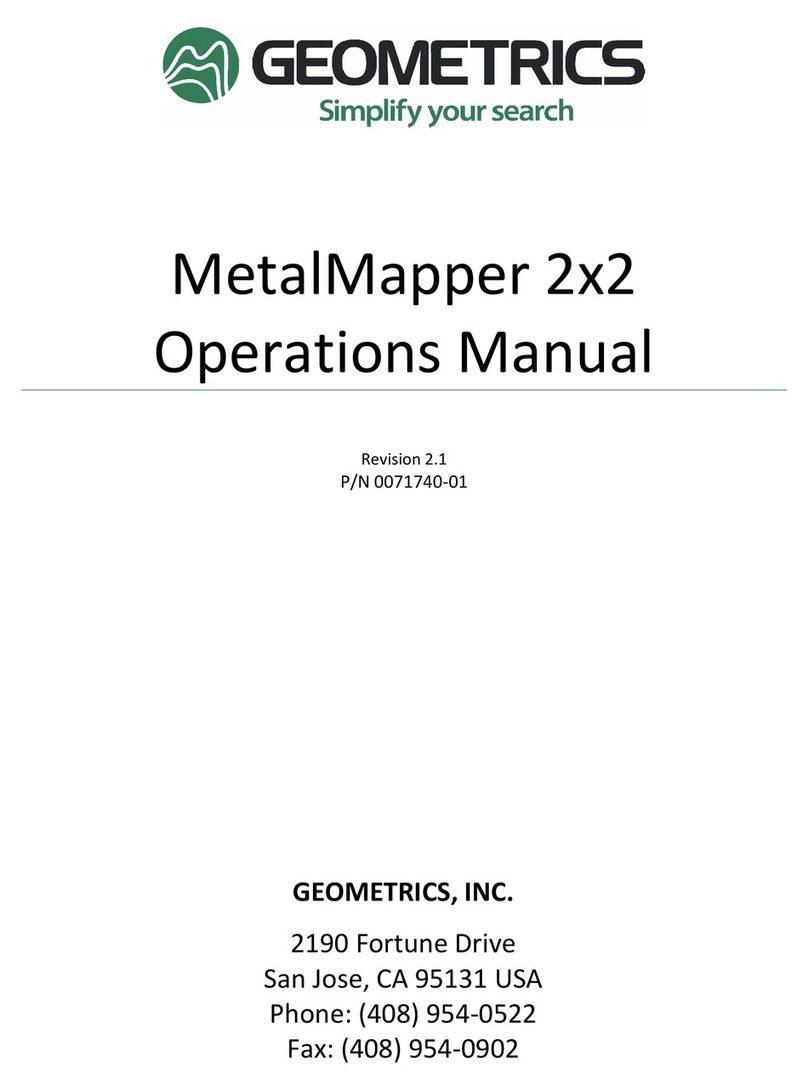
Geometrics
Geometrics MetalMapper 2x2 User manual
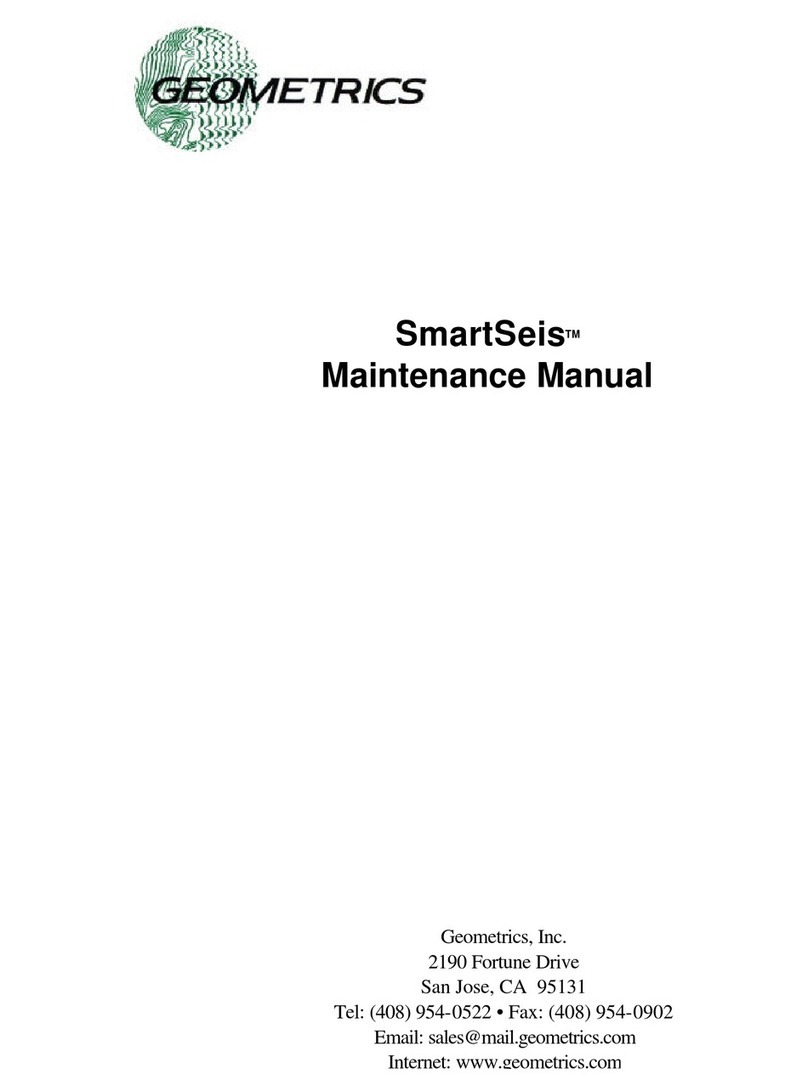
Geometrics
Geometrics SmartSeis User manual
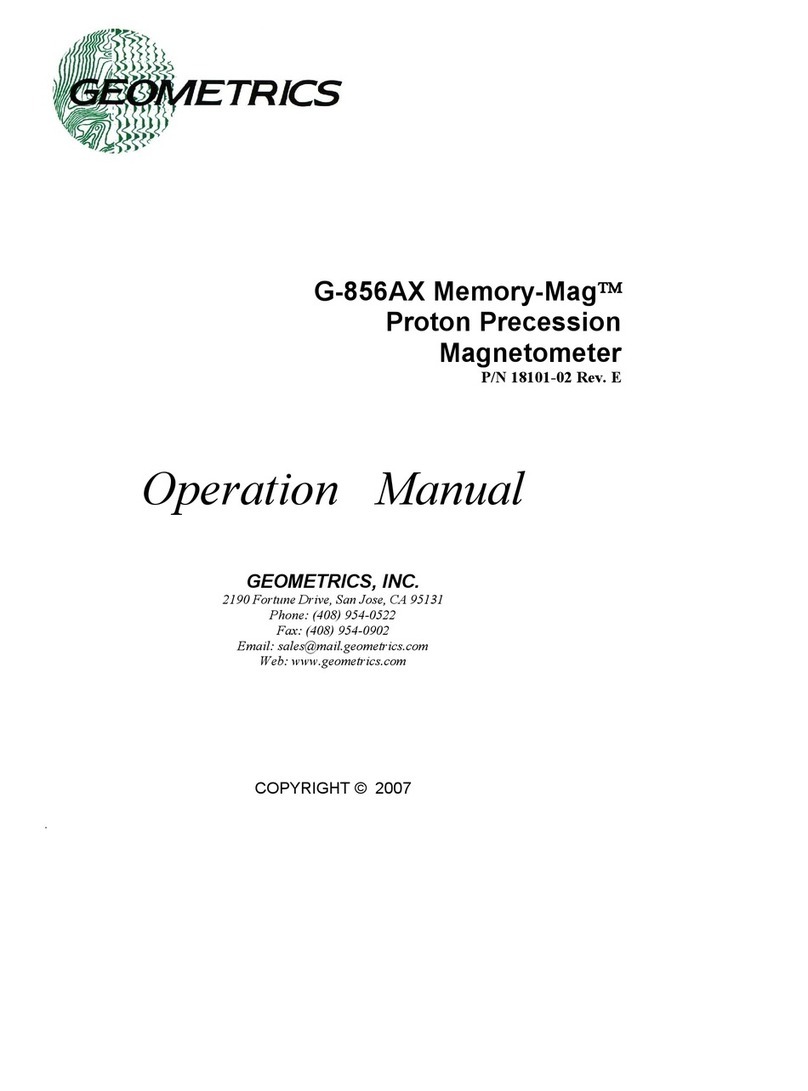
Geometrics
Geometrics Memory-Mag G-856AX User manual

Geometrics
Geometrics GemPen User manual
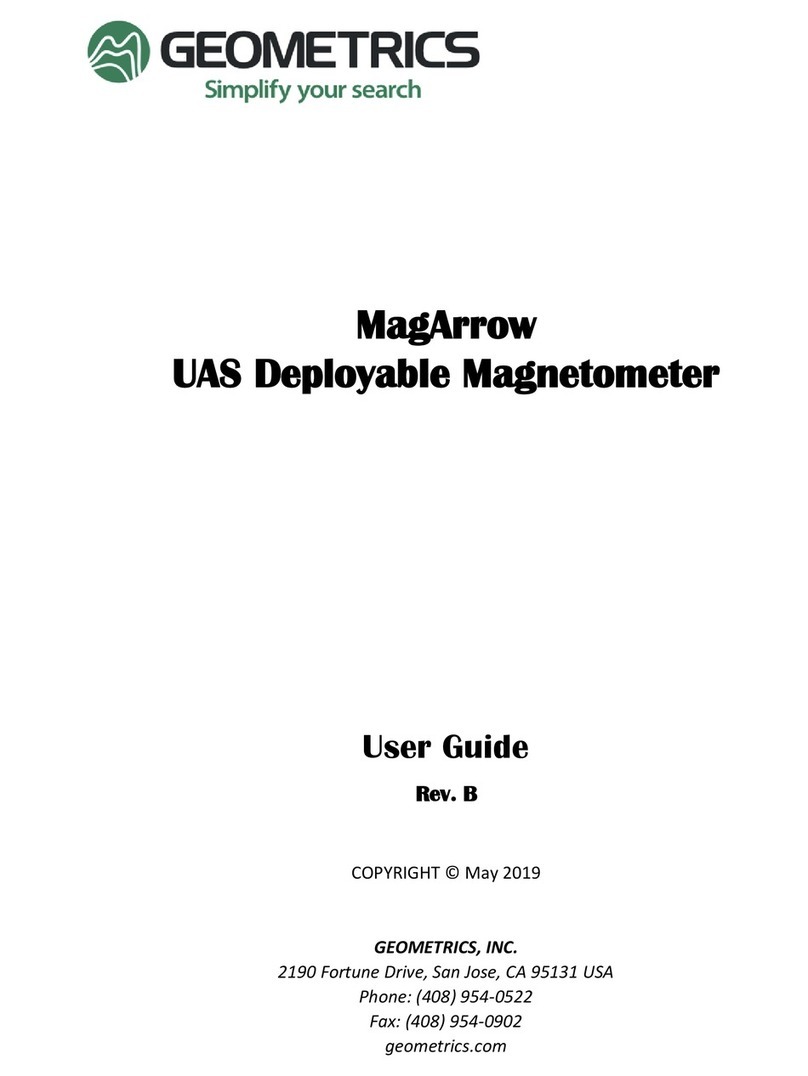
Geometrics
Geometrics MagArrow User manual

Geometrics
Geometrics MagEx User manual
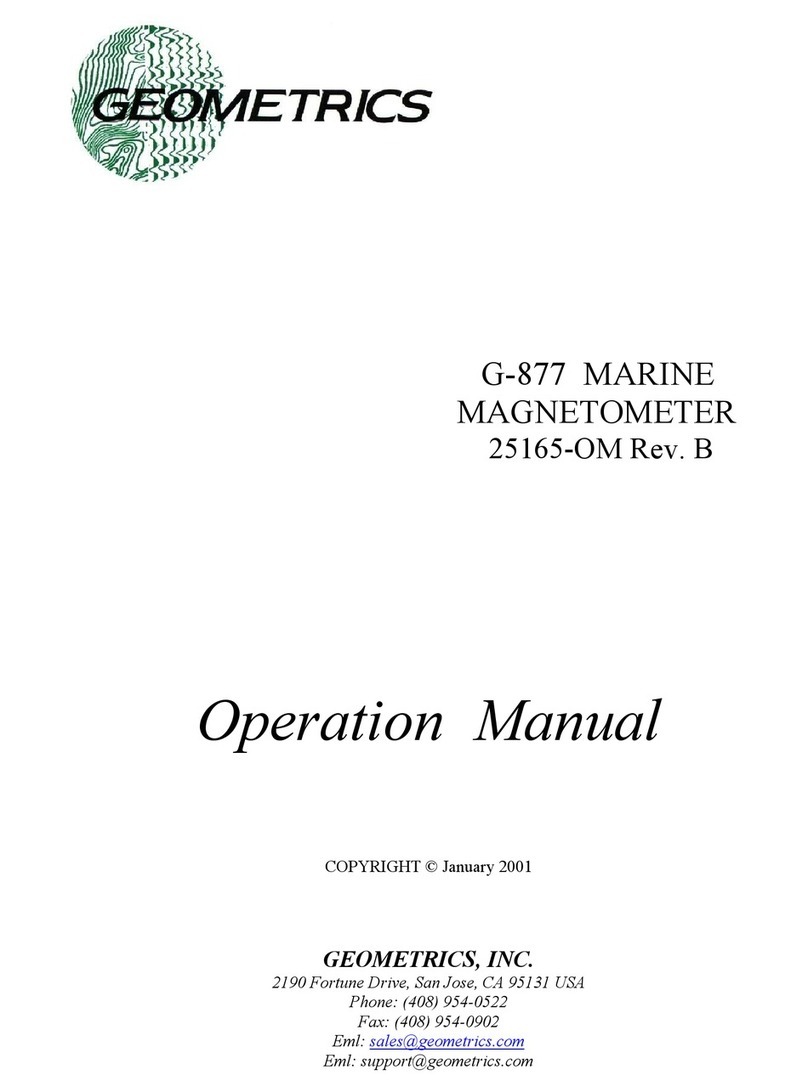
Geometrics
Geometrics G-877 User manual
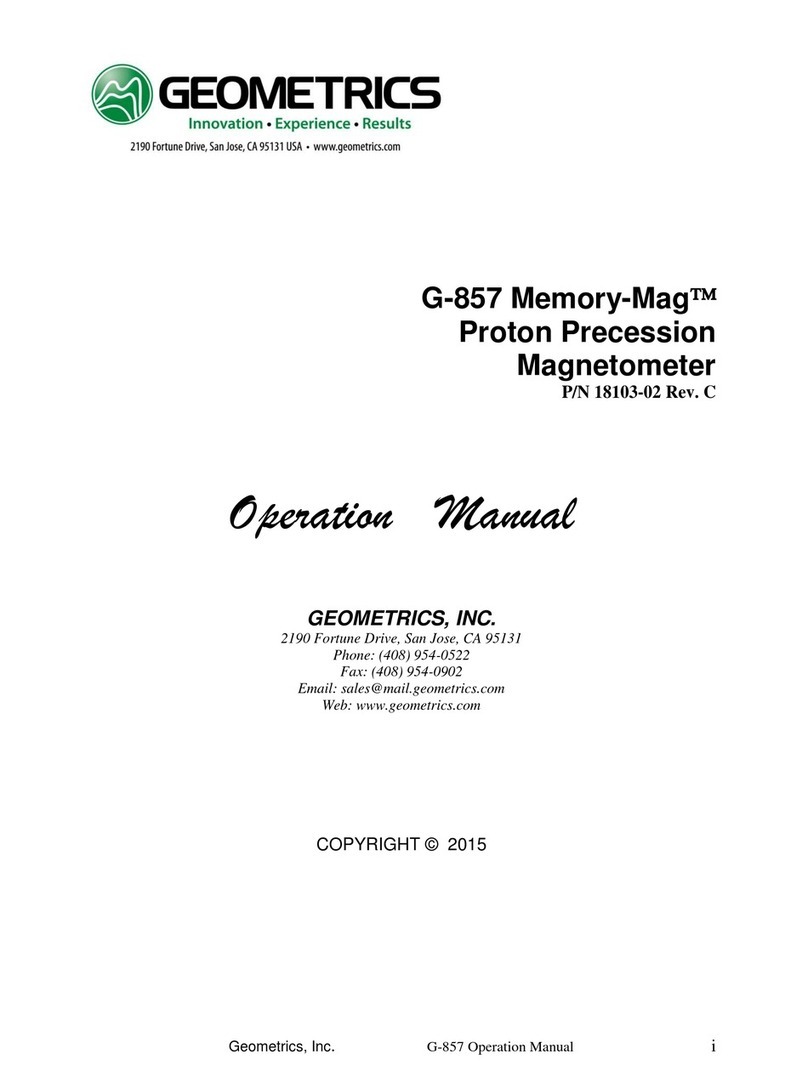
Geometrics
Geometrics Memory-Mag G-857 User manual

Geometrics
Geometrics Memory-Mag G-857 User manual
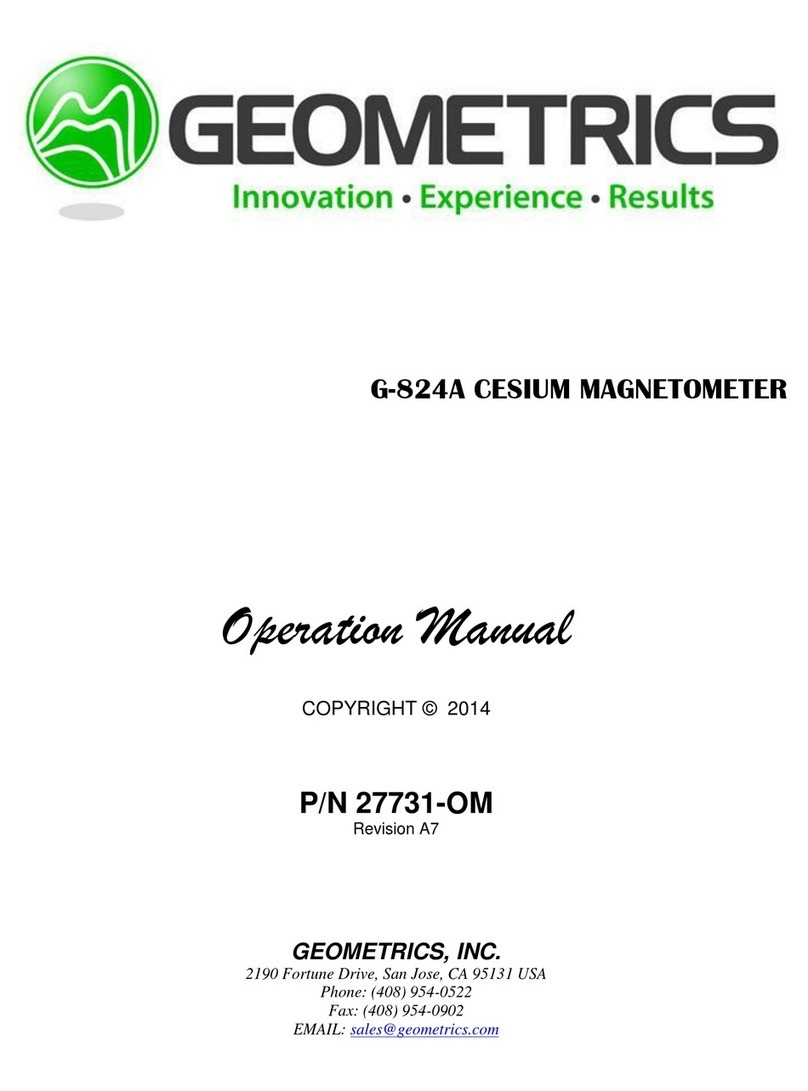
Geometrics
Geometrics G-824A User manual

